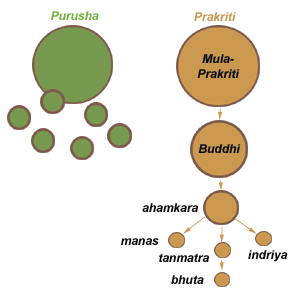Originally the three gunas were in complete balance. Prakriti was undis-turbed. This original condition is known as prakriti-pradhana or mula-prakriti, which is the natural foundation. When purusha came near, prakriti began to change.
A good analogy of this is you and your car. While you are away, your car just sits there in its original state. Once you see the car, the desire arises to sit in it, to turn it on. When you and your car come together, things start to happen. You begin to drive and go places. Soon you forget your car is not you. It feels like you. You can sense exactly where it is on the road. The car reacts to the other cars on the road as if it had a mind of its own. It notices things like traffic lights and pedestrians, almost as if it was conscious. Soon you and your car are one and you have forgotten why you ever got in the car in the first place.
Once purusha activates prakriti, the first evolute arises; the first thing to appear out of the natural foundation of prakriti-pradhana is mahat, the great principle. This is also known as buddhi or the awakened intelligence. Mahat is intuition, or cognition, but it is not consciousness. Only purusha is conscious. But, because of mahat’s great intelligence and luminosity, it is often mistaken for consciousness. Just as our car can sometimes seem to have a mind of its own, buddhi can seem to be conscious – it is an illusion.
From buddhi evolves ahamkara; the “I-maker.” Ahamkara creates the sense of self (with a small “s”), also known as ego. In this respect, ahamkara pretends to be purusha (which is Self with a big “S”). So now your car starts to act as if it’s the boss. Perhaps here our analogy begins to break down, but you probably know some people for whom their car is the boss. A small scratch on the fender can send some owners into great angst, and they act quickly to repair the superficial damage. It is at the level of ahamkara that subjects and objects arise. “I” becomes the subject, and the rest of the world provides its objects. At this level individualism arises because inherent in the subject/object duality there is separation. [1]

Purusha and Prakriti are completely distinct, making the Samkhya philosophy dualistic.
From ahamkara evolves manas, the mind, and the ten senses (the indriyas). Manas here is the lower mind, which we have seen in the kosha model. It is often described as the eleventh sense. [2] Also out of ahamkara arise the five elements (bhuta) and the five energy potentials (tanmatra). The elements we have seen before: space, air, fire, water, and earth. The five energy potentials are new to us. These are the tanmatras, the substances upon which the senses function. They are what is touched, what is tasted, what is smelled, what is heard, and what is seen.
What has not been explained yet are the other senses. Samkhya lists ten. Five we are very familiar with: these are called the “cognitive senses” – listening, feeling, seeing, tasting, and smelling. The remaining five are the conative senses: speaking, grasping, moving, excreting, and reproducing.
With these twenty-four principles, the Samkhya model is complete – a map of the inner and outer universe is offered to the psychonaut. While the map seems totally impossible to follow for us normal souls, this is a map blazed by those who have gone before us. Can we really critique what we have not experienced? But that raises the final question: how do we follow this map? What is the practice of Samkhya Yoga? How can we determine for ourselves if this map is accurate or not?
- — While there are countless separate and individual purushas in the Samkhya philosophy, these cannot be said to be either subjects or objects. While individual and separate, they are connected because each purusha is eternal and infinite. This, however, is one area where Samkhya was found wanting. How can there be countless individual purushas, each one all-knowing and infinite, without each purusha running afoul of all the other purushas. Samkhya’s strict adherence to its pluralistic purusha was one of its major downfalls. Another problem was its atheistic nature: there is no creator god in this cosmology. Every purusha is equal and equivalent to every other purusha. The final problem with Samkhya was its strict dualism. If purusha is distinct from prakriti, how can it ever become entangled in the first place?
- — It is interesting to consider mind as a sense. What does the mind sense? Consciousness? But that is purusha! Perhaps the sages meant that the mind senses thoughts.
(Next: The Practice of Samkhya Yoga )
